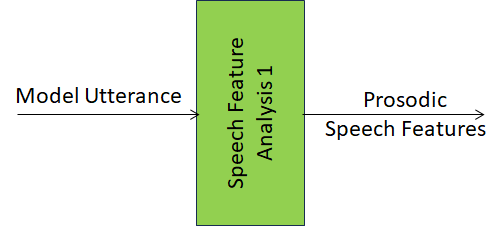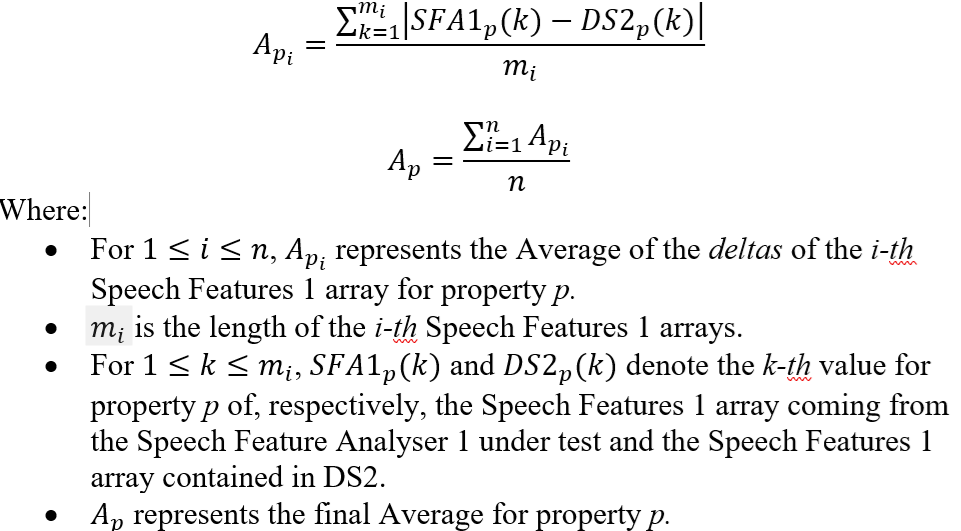| 1. Functions | 2. Reference Model | 3. Input/Output Data |
| 4. JSON Metadata | 5. SubAIMs | 6. Profiles |
| 7. Reference Software | 8. Conformance Testing | 9. Performance Assessment |
1 Functions
Speech Feature Analysis 1 (CAE-SF1):
| Receives | Model Utterance containing emotion. |
| Extracts | Speech Features1 from the Model Utterance. |
| Produces | Prosodic Speech Features. |
2 Reference Model
Figure 1 depicts the Speech Feature Analysis 1 (CAE-SF1) AIM:

Figure 1 – Speech Feature Analysis 1 (CAE-SF1) AIM
3 Input/Output Data
Table 1 gives the Input/Output Data of the Speech Feature Analysis 1 (CAE-SF1) AIM.
Table 1 – Input/Output Data of the Speech Feature Analysis 1 (CAE-SF1) AIM
| Input data | Semantics |
| Model Utterance | Utterance provided as a model. |
| Output data | Semantics |
| Prosodic Speech Features | A type of Speech Features (Descriptors). |
4 JSON Metadata
https://schemas.mpai.community/CAE1/V2.4/AIMs/SpeechFeatureAnalysis1.json
5 SubAIMs
No SubAIMs.
6 Profiles
No Profiles
7 Reference Software
Reference Software not available.
8 Conformance Testing
| Receives | Model Utterance | Shall validate against the Audio Object schema. The Qualifier shall validate against the Audio Qualifier schema. The values of any Sub-Type, Format, and Attribute of the Qualifier shall correspond with the Sub-Type, Format, and Attributes of the Audio Object Qualifier schema. |
| Produces | Prosodic Speech Features | Shall validate against the Speech Features Schema. |
9 Performance Assessment
Table 6 gives the Emotion Enhanced Speech (EES) Speech Feature Analyser1 Means (verification procedures) and how they are used.
Table 6 – Means and use of Emotion Enhanced Speech (EES) Speech Feature Analyser1 AIM
| Means | Actions |
| Conformance Testing Dataset | DS1: a dataset of at least n > M Model Utterances.
DS2: a dataset of n Speech Features 1 arrays, where each is associated with a specific utterance of DS1 used as input, and thus represents one correct output, given this input. |
| Procedure | For each of the n Model Utterances in input:
Then, compute the Average for each of the three properties among the n Model Utterances. Considering one of the three properties (pitch, intensity and duration) and denoting it as p, a mathematical representation of the computation for each property is:
|
| Evaluation |  |

Figure 3 – EES Speech Feature Analyser1.
After the Tests, Conformance Tester shall fill out Table 7.
Table 7 – Conformance Testing form of Emotion Enhanced Speech (EES) Speech Feature Analyser1 (AIM1)
| Conformance Tester ID | Unique Conformance Tester Identifier assigned by MPAI |
| Standard, Use Case ID and Version | Standard ID and Use Case ID, Version and Profile of the standard in the form “CAE:EES:1.2:0”. |
| Name of AIM | Speech Feature Analyser1 |
| Implementer ID | Unique Implementer Identifier assigned by Conformance Tester. |
| AIM Implementation Version | Unique Implementation Identifier assigned by Implementer. |
| Neural Network Version* | Unique Neural Network Identifier assigned by Implementer. |
| Identifier of Test Dataset | Unique Dataset Identifier assigned by Conformance Tester. |
| Test ID | Unique Test Identifier assigned by Conformance Tester. |
| Actual output | Actual output provided as a matrix of n+1 rows containing all computed Average values:
Result: Threshold: m Final evaluation: Passed / Not passed |
| Execution time* | Duration of test execution. |
| Test comment* | |
| Test Date | yyyy/mm/dd. |
* Optional field



